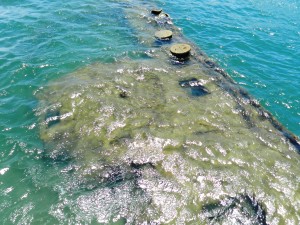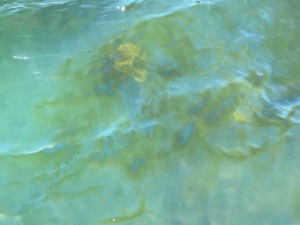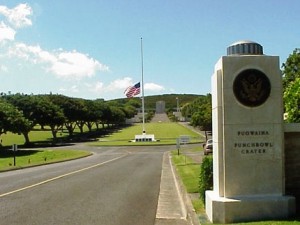» posted on Thursday, June 21st, 2012 by Linda Lou Burton
The Black Tear
 Linda Burton posting from Honolulu, Hawaii – “To the best of our knowledge, there are 13 remaining survivors,” the Ranger told us, as we gathered on the windy platform that stands sentinel over the remains of the USS Arizona. Out of the crew of 1,511, there were 334 crewmen who survived the December 7 attack, 1941. We were shown the movie first; live footage of events and fears that led up to the attack; Japanese and US defense strategies; consequences. Now here, peering down into the waters of Pearl Harbor, we see the rusted evidence of that day, an iridescent oil slick shimmering in the waves part of the story too.
Linda Burton posting from Honolulu, Hawaii – “To the best of our knowledge, there are 13 remaining survivors,” the Ranger told us, as we gathered on the windy platform that stands sentinel over the remains of the USS Arizona. Out of the crew of 1,511, there were 334 crewmen who survived the December 7 attack, 1941. We were shown the movie first; live footage of events and fears that led up to the attack; Japanese and US defense strategies; consequences. Now here, peering down into the waters of Pearl Harbor, we see the rusted evidence of that day, an iridescent oil slick shimmering in the waves part of the story too.
 The Ranger continued. “When any survivor passes, should they choose, they will be cremated and their ashes and their family flown to Pearl Harbor. When the Memorial is closed for the day, the family will gather here for the ceremony. Afterwards, their sealed urn is presented to divers, who then swim with the urn into the open barbette of Gun Turret IV and proceed to a large open slot. The urn is placed into the slot where it slides into the ship, allowing the deceased to come to rest with his shipmates. When the last survivor is laid to rest, the Black Tear will stop.”
The Ranger continued. “When any survivor passes, should they choose, they will be cremated and their ashes and their family flown to Pearl Harbor. When the Memorial is closed for the day, the family will gather here for the ceremony. Afterwards, their sealed urn is presented to divers, who then swim with the urn into the open barbette of Gun Turret IV and proceed to a large open slot. The urn is placed into the slot where it slides into the ship, allowing the deceased to come to rest with his shipmates. When the last survivor is laid to rest, the Black Tear will stop.” 
The Black Tear is an oil leak; it’s estimated that about nine quarts a day surface from the ship; it carried 1.4 million gallons of fuel when it sank that day (since it was immediately contaminated with salt water, it lost its value and was not recovered). And, according to the Ranger, once no more survivors remain, the ship will be sealed. Many facts and figures supplement the emotional range of the story — how many died; the number of attack planes; the minutes it took to realize what was happening; the speed of the recovery after the attack; the dollar value of materials salvaged — mind boggling numbers that somehow slide over my head; it’s too much to grasp. It’s said that those 334 survivors suffered guilt for being survivors at all; that a longing persists to join their crewmates. Good that a return is allowed; a somber honor, visible as a slick of oil.
 There’s visibility on the hill above Honolulu too, at Punchbowl Cemetery, officially titled the National Memorial Cemetery of the Pacific. A volcanic crater where Hawaiians once offered human sacrifice to pagan gods, it’s still a reminder of sacrifice today; over 13,000 sailors and soldiers and marines who died in WWII are buried there. Space is available for more cremated remains.
There’s visibility on the hill above Honolulu too, at Punchbowl Cemetery, officially titled the National Memorial Cemetery of the Pacific. A volcanic crater where Hawaiians once offered human sacrifice to pagan gods, it’s still a reminder of sacrifice today; over 13,000 sailors and soldiers and marines who died in WWII are buried there. Space is available for more cremated remains.
http://www.nps.gov/valr/index.htm
http://www.nps.gov/valr/planyourvisit/nearby-attractions.htm
http://travelpod.com/members/burtonll
